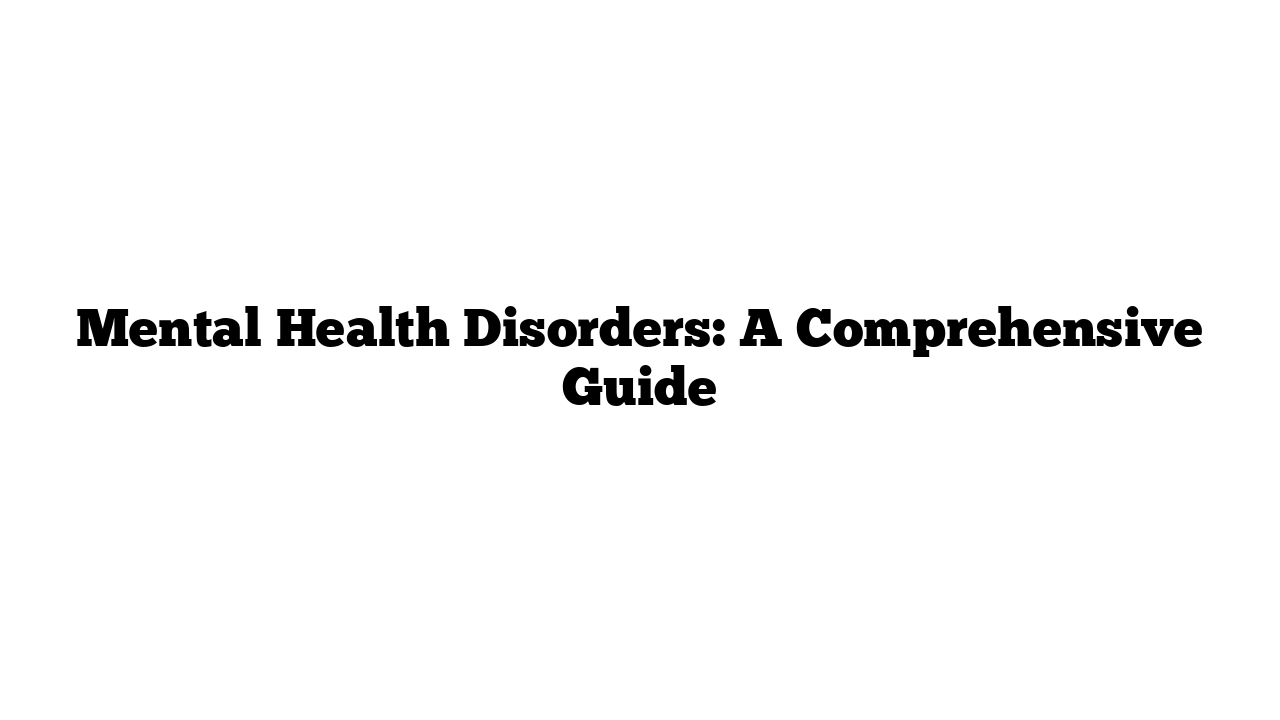Understanding mental health disorders is essential for improving awareness and reducing stigma. Below, we explore various mental health conditions, their symptoms, and how they affect people.
This guide aims to provide trustworthy, easy-to-understand information.
Eating Disorders
Binge Eating Disorder (BED)
Binge eating disorder involves frequent episodes of consuming large amounts of food rapidly, often to the point of physical discomfort. This behavior is not accompanied by purging, distinguishing it from bulimia.
Anorexia Nervosa
Characterized by an intense fear of gaining weight, anorexia leads to extreme food restriction, self-imposed hunger, and a distorted body image.
Bulimia Nervosa
Bulimia involves cycles of overeating followed by compensatory behaviors such as vomiting, fasting, or excessive exercise.
Memory and Cognitive Disorders
Amnesia
Amnesia refers to partial or total memory loss, often triggered by trauma or psychological distress.
Dissociative Fugue
This rare condition includes sudden travel or wandering, coupled with an inability to recall one’s past or personal identity.
Personality Disorders
Borderline Personality Disorder (BPD)
Individuals with BPD experience mood swings, unstable self-image, and difficulties in relationships.
Antisocial Personality Disorder (ASPD)
Commonly known as sociopathy, ASPD features a persistent disregard for others’ rights, impulsivity, and lack of empathy.
Histrionic Personality Disorder
This disorder is marked by excessive emotionality, attention-seeking behavior, and a constant need for approval.
Avoidant Personality Disorder
Avoidant personality disorder is characterized by extreme social inhibition, feelings of inadequacy, and hypersensitivity to criticism.
Developmental Disorders
Autism Spectrum Disorder (ASD)
Autism includes challenges with social interaction, communication, and repetitive behaviors. It exists on a spectrum, meaning severity varies greatly.
Attention Deficit Hyperactivity Disorder (ADHD)
ADHD involves patterns of inattention, hyperactivity, and impulsivity that interfere with daily functioning.
Dyslexia
This learning disorder impacts a person’s ability to read and write fluently, despite normal intelligence.
Anxiety Disorders
Generalized Anxiety Disorder (GAD)
Characterized by persistent, excessive worry about daily life, GAD often comes with physical symptoms such as restlessness and muscle tension.
Social Anxiety Disorder
Individuals with social anxiety disorder experience intense fear in social situations, often avoiding them altogether.
Agoraphobia
Agoraphobia involves fear of places or situations where escape might be difficult, such as crowded areas or public transportation.
Obsessive and Compulsive Disorders
Dermatillomania
Also known as skin-picking disorder, this condition leads to repeated skin picking, causing tissue damage.
Trichotillomania
This disorder involves compulsive hair-pulling, resulting in noticeable hair loss.
Bibliomania
Bibliomania is an obsessive-compulsive disorder where individuals excessively collect books, often at the expense of other life priorities.
Mood Disorders
Bipolar Disorder
Bipolar disorder alternates between episodes of mania (elevated mood) and depression.
Depressive Personality Disorder
Marked by persistent feelings of sadness, inadequacy, and loneliness, this condition can severely impact daily life.
Rare and Unique Disorders
Folie à Deux
A rare condition where a delusional belief is shared between two closely connected individuals.
Rumination Syndrome
Involves regurgitating food, which is then re-chewed, swallowed, or spit out, without a medical cause.
Munchausen Syndrome
Individuals fabricate or exaggerate symptoms to assume the role of a patient.
Psychotic Disorders
Schizophrenia
Schizophrenia is a severe mental health condition featuring delusions, hallucinations, and disorganized thinking.
Brief Psychotic Disorder
Short episodes of psychosis, including hallucinations and delusions, characterize this disorder.
Sleep and Behavioral Disorders
Primary Insomnia
Difficulty initiating or maintaining sleep, primary insomnia is not linked to any other health condition.
Sleepwalking Disorder
This involves engaging in complex activities while partially awake, with no memory of the event.
Nightmare Disorder
Recurrent nightmares causing significant distress or interference in daily functioning.
Other Notable Conditions
Body Dysmorphic Disorder
Involves excessive preoccupation with perceived physical flaws.
Dependent Personality Disorder
Individuals exhibit an overwhelming need to be cared for and fear separation.
Alcohol and Substance Abuse
Refers to the harmful use or dependence on substances, including withdrawal symptoms and difficulty controlling usage.
Final Thoughts
Mental health conditions affect millions of people across the globe. Early recognition, understanding, and treatment are essential for managing these disorders effectively. If you or someone you know is experiencing symptoms, reach out for professional help. For more insightful articles, visit medicaltimes.io.
Reference Websites
FAQs
- What is the most common mental illness in the USA?
Anxiety disorders, including GAD and social anxiety disorder, are the most common. - Can mental health disorders be cured?
While some can be effectively managed or treated, others may require lifelong coping strategies. - Is schizophrenia hereditary?
Genetics play a role, but environmental factors are also significant. - How is ADHD treated?
Treatment includes behavioral therapy, medication, and educational support. - What is the difference between a psychiatrist and a psychologist?
Psychiatrists are medical doctors who can prescribe medication, while psychologists focus on therapy and counseling. - What causes bipolar disorder?
A combination of genetic, environmental, and chemical imbalances in the brain. - Can children have eating disorders?
Yes, eating disorders can occur in children and require early intervention. - What is the first step in seeking help for mental illness?
Consult a healthcare professional for an accurate diagnosis and treatment plan. - How common is autism in the USA?
Approximately 1 in 44 children in the USA are diagnosed with autism. - What support resources are available for mental health in the USA?
Hotlines, counseling centers, and community support groups are widely accessible.
